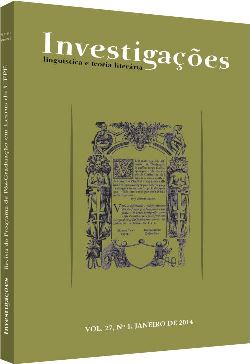The Vertigo of Technology and its Uncanniness
Resumo
Published for the first time during the 1930’s Great Depression, Vertigo is a “wordless novel”, according to its author Lynd Ward. This work marks the historic moment when various technologies are integrated to the urban life, such as the train, the telephone and the cars, showing how these changes interact with the capitalist crisis lived at that time. Thus, Ward recreates multiple sensations of vertigo using the woodcutting technique in this precursor of the graphic novel. This article relates the impacts of technology to the notion of uncanny and the reception of this work among artists.
Referências
AUSTER, Paul. 1994. Mr. Vertigo. Great Britain: Faber and Faber Limited.
EISNER, Will. 1985. Comics and Sequential Art. United States: Poorhouse Press.
FREUD, Sigmund. 1919. The Uncanny. San Diego: San Diego State University. Available at: http://www-rohan.sdsu.edu/~amtower/uncanny.html.
GARCÍA, Santiago. 2010. A Novela Gráfica. São Paulo: Martins Fontes.
JENTSCH, Ernst. 1906. On the Psychology of the Uncanny. Illinois: Northwestern University. Translated by Roy Sellars. Available at: http://faculty-web.at.northwestern.edu/german/uncanny/Jentsch.pdf.
McCARTHY, Tom. 2010. Technology and the novel, from Blake to Ballard. The Guardian. Available at: http://www.guardian.co.uk/books/2010/jul/24/tom-mccarthy-futurists-novels-technology.
McCLOUD, Scott. 1993. Understanding Comics. United States: Harper Collins.
WARD, Lynd. 2009. Vertigo: a novel in woodcuts. New York: Dover.
______. 1934. The monster gazes into a pool. Illustrations for Frankenstein. Available at: http://paganpressbooks.com/jpl/LYNDWARD.HTM.
Downloads
Publicado
Como Citar
Edição
Seção
Licença
Copyright (c) 2015 Gabriela Semensato Ferreira

Este trabalho está licenciado sob uma licença Creative Commons Attribution 4.0 International License.
Autores que publicam na Revista Investigações concordam com os seguintes termos:
Autores mantêm os direitos autorais e concedem à revista o direito de primeira publicação, com o trabalho simultaneamente licenciado sob a licença Creative Commons Atribuição 4.0 Internacional (CC BY 4.0) que permite o compartilhamento do trabalho com reconhecimento da autoria e publicação inicial nesta revista.
Autores têm autorização para assumir contratos adicionais separadamente, para distribuição não-exclusiva da versão do trabalho publicada nesta revista (exemplo: depositar em repositório institucional ou publicar como capítulo de livro), com reconhecimento de autoria e publicação inicial nesta revista.
Qualquer usuário tem direito de:
Compartilhar — copiar e redistribuir o material em qualquer suporte ou formato para qualquer fim, mesmo que comercial.
Adaptar — remixar, transformar e criar a partir do material para qualquer fim, mesmo que comercial.
O licenciante não pode revogar estes direitos desde que você respeite os termos da licença.
De acordo com os termos seguintes:
Atribuição — Você deve dar o crédito apropriado, prover um link para a licença e indicar se mudanças foram feitas. Você deve fazê-lo em qualquer circunstância razoável, mas de nenhuma maneira que sugira que o licenciante apoia você ou o seu uso.
Sem restrições adicionais — Você não pode aplicar termos jurídicos ou medidas de caráter tecnológico que restrinjam legalmente outros de fazerem algo que a licença permita.

